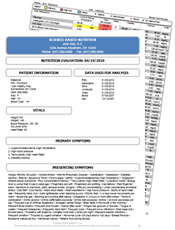Urinary Tract Infections
According to the National Kidney Foundation more than 20 million Americans-one in nine adults- have chronic kidney disease, and most don’t even know it (1). A urinalysis examines a sample of urine that can detect medical problems such as diabetes, liver disease, metabolic problems, urinary tract infections, and kidney disease. This quick and easy test can help to detect many diseases before symptoms occur or just to check your overall health status. Prevention of serious diseases can be implemented with early detection and treatment. UA should be considered if you’re experiencing back pain, abdominal pain, blood in the urine, painful or frequent urination. These
A visual examination is done first to note the color and clearness of the urine. The color should be a light yellow. If darker urine is seen you may be dehydrated. Or if the urine is cola colored you want to seek medical attention because this could indicate blood or kidney disease. Some foods such as asparagus and beets as well as multivitamins and B vitamins may change the color or your urine as well. The clarity of the urine is also noted. Cloudiness can indicate bacteria or infections.
Other Tests Checked by a Urinalysis
Specific gravity. This checks how well the kidneys are balancing water with substances and waste products. The higher the specific gravity, the more solid material is in the urine. The more fluid you drink, the more water in the urine which creates a low specific gravity (2).
pH. The pH measures how acidic or alkaline the urine is. A urine pH of 4 is strongly acidic, 7 is neutral and 9 is strongly alkaline. “Bacterial infections, kidney failure, urinary tract infections (UTI), and a diet high in citrus fruits and dairy may raise the pH. A lower pH can be associated with diabetes, diarrhea, and a diet high in meat products or cranberries (3).”
Protein. Protein is not normally found in the urine. When the kidneys are damaged, protein can leak into your urine. If traces are present this may be associated with fever, exercise, pregnancy, or kidney disease. Persistent protein in the urine (two positive tests for protein over several weeks) is one of the earliest signs of chronic kidney disease (1).
Glucose. Very little or no glucose is normally found in urine. Sugar can be spilled into the urine when blood sugar level is high as in such cases of diabetes.
Nitrites. Nitrites in the urine indicate a urinary tract infection.
Leukocytes. This type of white blood cell present in the urine indicates presence of a urinary tract infection.
Urinary tract infections are the second most common type of infection in the body, “accounting for about 8.1 million visits to health care providers each year. And about 20 percent of young women with a first UTI will have a recurrent infection (4).” This many times is due to antibiotic prescriptions taken for the infection which does not address the cause of the infection and will leave them open for future, recurrent infections. “The only thing that patients seek visitations to the doctor more for are respiratory tract infections, such as the common cold (5).” Most UTIs are not serious. However, if they keep reoccurring, identification and treatment of the underlying cause is essential.
Recommendations for Urinary Tract Infections
- Drink ONLY water! 2-3 quarts a day. Water helps flush the urinary tract.
- Vitamin C at 5000 mg/day. Vitamin C increases the acidity level of urine, which helps decrease the number of harmful bacteria that may be present in your urinary tract system.
- Biodophilus at 2/day. This beneficial bacteria can be restored to treat urogenital an gastrointestinal infections. It can also counteract long term antibiotic use which can destroy the healthy bacteria allowing infectious agents to sustain.
- Cranberry juice concentrate. With the cranberry’s acidic properties it can help inhibit the Escherichia coli (E. Coli) bacteria from attaching to the lining of the urinary tract (6). E. Coli is the number cause of UTI’s. However, if you are a diabetic be cautious of the amount of sugar cranberry juices contain. Seek out the real cranberry concentrates and not the frozen concoctions that you reconstitute.
- D-Mannose is a naturally occurring sugar found in some plants including cranberries. D-Mannose has been shown to adhere to bacteria, preventing them from sticking to the lining of the bladder.
- Stop eating refined carbs and greatly limit all carbohydrates in the form of breads, pastas, and rice.
We carry these products to pick up or we can order and ship them to your door.
UA test-$15
Disclaimer: This is general health tips for informational purposes and should not be construed as individual health advice nor does it replace an exam or treatment recommendations of a health care provider. Please consult the advice of a doctor and call us for an appointment.
References:
- National Kidney Foundation, Inc. 2002. www.kidney.org Accessed 01/18/12
- Healthwise. WebMD. September 01, 2010. http://www.webmd.com/a-to-z-guides/urine-test. Accessed 01/18/12
- Landry DW, Bazari H. Approach to the patient with renal disease. Cecil Medicine. 24th ed. Philadelphia, Pa: Saunders Elsevier; 2011:chap 116.
- Schappert SM, Rechtsteiner EA. Ambulatory medical care utilization estimates for 2006. National health statistics reports; no 8. Hyattsville, MD: National Center for Health Statistics; 2008.
- Cornforth, Tracee. Ten Ways to Prevent Urinary Tract Infections. http://www.nichd.nih.gov/health/topics/urinary_tract_infections.cfm. Accessed 01/18/12
- Chandler, Jessica. The Truth About Cranberry Juice Preventing Urinary Tract Infections. Health Psychology Department. Vanderbilt University 10-7-2006.

